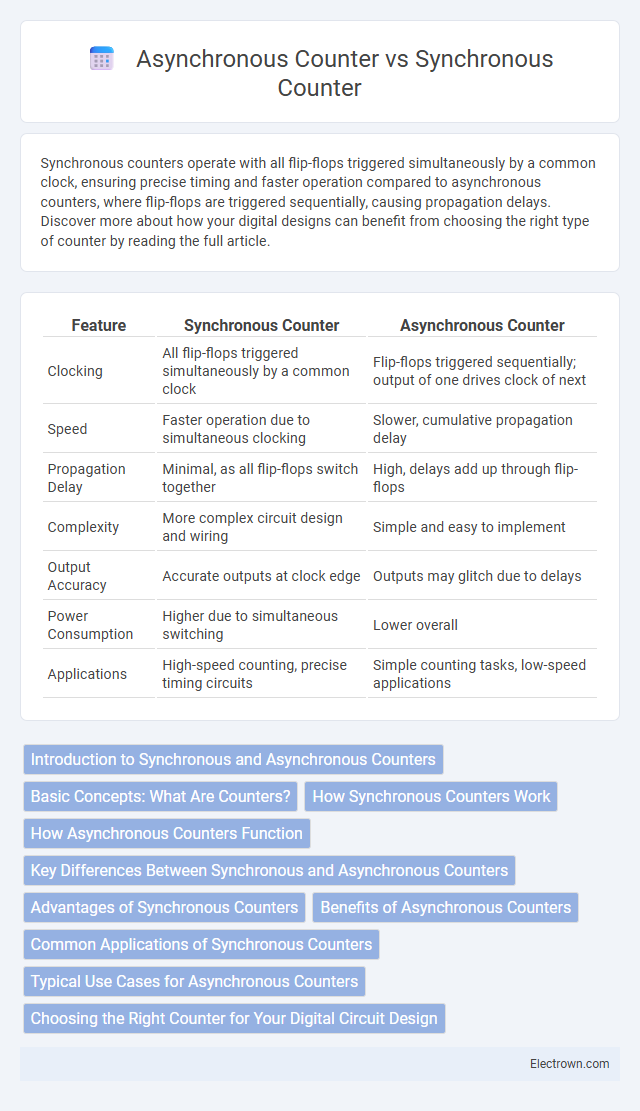Synchronous counters operate with all flip-flops triggered simultaneously by a common clock, ensuring precise timing and faster operation compared to asynchronous counters, where flip-flops are triggered sequentially, causing propagation delays. Discover more about how your digital designs can benefit from choosing the right type of counter by reading the full article.
Table of Comparison
| Feature | Synchronous Counter | Asynchronous Counter |
|---|---|---|
| Clocking | All flip-flops triggered simultaneously by a common clock | Flip-flops triggered sequentially; output of one drives clock of next |
| Speed | Faster operation due to simultaneous clocking | Slower, cumulative propagation delay |
| Propagation Delay | Minimal, as all flip-flops switch together | High, delays add up through flip-flops |
| Complexity | More complex circuit design and wiring | Simple and easy to implement |
| Output Accuracy | Accurate outputs at clock edge | Outputs may glitch due to delays |
| Power Consumption | Higher due to simultaneous switching | Lower overall |
| Applications | High-speed counting, precise timing circuits | Simple counting tasks, low-speed applications |
Introduction to Synchronous and Asynchronous Counters
Synchronous counters operate with all flip-flops triggered simultaneously by a common clock signal, resulting in faster and more reliable counting performance. In contrast, asynchronous counters, also known as ripple counters, trigger flip-flops in sequence, causing propagation delays due to the staggered clock input. Understanding the difference between synchronous and asynchronous counters is crucial for designing digital circuits that require precise timing and speed for Your counting applications.
Basic Concepts: What Are Counters?
Counters are digital circuits designed to count pulses and provide a binary or decimal output representing the count value. Synchronous counters update all their flip-flops simultaneously using a common clock signal, ensuring faster and more reliable operation compared to asynchronous counters, where flip-flops are triggered sequentially and introduce propagation delays. Understanding the basic concept of counters helps you select the right type for applications requiring precise timing and counting accuracy.
How Synchronous Counters Work
Synchronous counters operate by triggering all flip-flops simultaneously with the same clock pulse, ensuring that each stage changes state in unison. This simultaneous clocking eliminates the propagation delay found in asynchronous counters, resulting in faster and more reliable counting. Your digital circuits benefit from enhanced timing accuracy and improved performance when using synchronous counters in sequential counting applications.
How Asynchronous Counters Function
Asynchronous counters, also known as ripple counters, operate by allowing each flip-flop to trigger the next one in the sequence asynchronously, with the output of one flip-flop serving as the clock input for the next. This ripple effect causes a propagation delay, as the counting occurs sequentially rather than simultaneously across all flip-flops. These counters are simpler in design but are limited in speed due to cumulative delays affecting their performance in high-frequency applications.
Key Differences Between Synchronous and Asynchronous Counters
Synchronous counters have all their flip-flops triggered simultaneously by a common clock signal, leading to faster operation and reduced propagation delay compared to asynchronous counters, where flip-flops are triggered sequentially. Asynchronous counters, also known as ripple counters, are simpler and require fewer wiring connections but suffer from cumulative delays as each flip-flop waits for the previous one's output. Synchronous counters offer improved performance in high-speed applications due to their parallel clocking, whereas asynchronous counters are suitable for low-speed or simple counting tasks.
Advantages of Synchronous Counters
Synchronous counters offer faster operation compared to asynchronous counters due to simultaneous clocking of all flip-flops, eliminating propagation delay issues. They provide improved timing accuracy and reliable performance in high-speed applications such as digital clocks and frequency dividers. Enhanced ease of design and synchronization makes synchronous counters preferable for complex sequential circuits.
Benefits of Asynchronous Counters
Asynchronous counters offer the benefit of simpler design and lower power consumption due to their fewer flip-flops and absence of a global clock signal, making them suitable for low-speed applications. They are easier to implement with reduced wiring complexity, which helps minimize hardware costs and debugging time. Your choice of an asynchronous counter can enhance efficiency in circuits where timing delays are acceptable but simplicity and cost-effectiveness are prioritized.
Common Applications of Synchronous Counters
Synchronous counters are widely used in applications requiring precise timing and simultaneous state changes, such as digital clocks, frequency dividers, and event counters in microprocessors. Their ability to operate reliably at high speeds makes them ideal for synchronous state machines and binary-coded decimal (BCD) counters in digital systems. These counters are preferred in applications where minimizing propagation delay and ensuring synchronized outputs are critical.
Typical Use Cases for Asynchronous Counters
Asynchronous counters, known for their simple design and low power consumption, are typically used in applications where counting speed is less critical, such as frequency division, debouncing switches, and simple event counting. Their ease of implementation makes them ideal for low-frequency digital clocks and simple timer circuits. Despite slower operation compared to synchronous counters, asynchronous counters remain popular in basic digital logic and educational projects.
Choosing the Right Counter for Your Digital Circuit Design
Choosing the right counter for your digital circuit design depends on speed and complexity requirements; synchronous counters offer faster operation with simultaneous clocking of all flip-flops, reducing propagation delay compared to asynchronous counters that trigger changes sequentially. Your design benefits from synchronous counters in high-frequency applications with minimal latency, while asynchronous counters suit simpler, low-speed circuits due to their ease of implementation and lower power consumption. Optimize your digital system performance by matching the counter type to the specific timing, power, and complexity needs of your project.
Synchronous Counter vs Asynchronous Counter Infographic

 electrown.com
electrown.com